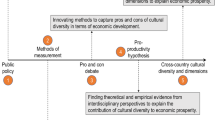Abstract
Cultural policy is an emerging field of research that attracts scholars in many disciplines ranging from cultural studies, cultural sociology, public policy studies, and media studies to cultural economics. More recently, with a growing interest from policy makers and academics on the creative industries and creative economy, the scope of and themes within cultural policy research have been broadened further. As a new and interdisciplinary field, the research makes use of conceptual and theoretical tools drawn from various disciplines. The difficulty in clearly defining key subject knowledge and theoretical frameworks, however, indicates that perhaps cultural policy is closer to a theme shared by those disciplines than a discrete area of study (Kawashima forthcoming). This implies that there are multiple, sometimes independent, sets of keywords and analytical approaches to studying this area. For instance, cultural economists (Peacock and Rizzo 1994) and critical cultural theorists (McGuigan 2004) provide two very different ways of understanding culture-state relations. As cultural policy research advances and matures, we expect that there will be more calls for it to develop its own language and theoretical perspectives.
Access this chapter
Tax calculation will be finalised at checkout
Purchases are for personal use only
Preview
Unable to display preview. Download preview PDF.
Similar content being viewed by others
References
Ahearne, J. (2009) ‘Cultural Policy Explicit and Implicit: A Distinction and Some Uses’, International Journal of Cultural Policy, 15(2), 141–153.
Bourdieu, P. (1993) The Field of Cultural Production (Cambridge: Polity).
Chua, B. and Iwabuchi, K. (2008) East Asian Pop Culture: Analysing the Korean Wave (Hong Kong: Hong Kong University Press).
Cunningham, S. (2009) ‘Trojan Horse or Rorschach Blot? Creative Industries Discourse around the World’, International Journal of Cultural Policy, 15(4), 375–386.
Iwabuchi, K. (2002) Recentering Globalization: Popular Culture and Japanese Transnationalism (London: Duke University Press).
Kawashima, N. (forthcoming) ‘An Overview of Cultural Policies in East Asia’, in J.D. Wright (ed.), International Encyclopaedia of Social and Behavioral Sciences (2nd edition) (Oxford: Elsevier).
Kim, Y. (ed.) (2013) The Korean Wave: Korean Media Go global (London: Routledge).
Kong, L., Gibson, C., Khoo, L.-M. and Semple, A.-L. (2006) ‘Knowledges of the Creative Economy: Towards a Rational Geography of Diffusion and Adaptation in Asia’, Asia Pacific Viewpoint, 47(2), 173–194.
McGuigan, J. (2004) Rethinking Cultural Policy (Maidenhead: Open University Press).
Peacock, A. and Rizzo, I. (eds) (1994) Cultural Economic and Cultural Policies (London: Kluwer Academic Publishers).
Rozman, G. (ed.) (1991) The East Asian Region Confucian Heritage and Its Modern Adaptation (Princeton: Princeton University Press).
Toepler, S. and Zimmer, A. (2002) ‘Subsidizing the Arts: Government and the Arts in Western Europe and the United States’, in D. Crane, N. Kawashima and K. Kawasaki (eds), Global Culture: Media, Arts, Policy and Globalization (London: Routledge), 29–48.
Tomooka, K., Kanno, S. and Kobayashi, M. (2002) ‘Building National Prestige: Japanese Cultural Policy and the Influence of Western Institutions’, in D. Crane, N. Kawashima and K. Kawasaki (eds), Global Culture: Media, Arts, Policy and Globalization (London: Routledge), 49–62.
Tong, Q.S. and Hung, R. (2012) ‘Cultural Policy between the State and the Market: Regulation, Creativity and Contradiction’, International Journal of Cultural Policy, 18(3), 265–278.
Tu, W. (2000) ‘Implications of the Rise of “Confucian” East Asia’, Daedalus, 129(1), 195–218.
The World Bank (2013) GDP ranking, http://data.worldbank.org/data-catalog/GDP-ranking-table, data accessed October 10, 2013.
UNdata (2013) Surface Area, http://data.un.org/Data.aspx?d=WDI&f=Indicator_Code%3AAG.SRF.TOTL.K2, data accessed October 10, 2013.
Vogel, Ezra F. (1991) The Four Little Dragons: The Spread of Industrialization in East Asia (Cambridge: Massachusetts: Harvard University Press).
Editor information
Editors and Affiliations
Copyright information
© 2014 Hye-Kyung Lee and Lorraine Lim
About this chapter
Cite this chapter
Lee, HK., Lim, L. (2014). Cultural Policies in East Asia: An Introduction. In: Lee, HK., Lim, L. (eds) Cultural Policies in East Asia. Palgrave Macmillan, London. https://doi.org/10.1057/9781137327772_1
Download citation
DOI: https://doi.org/10.1057/9781137327772_1
Publisher Name: Palgrave Macmillan, London
Print ISBN: 978-1-349-46019-9
Online ISBN: 978-1-137-32777-2
eBook Packages: Palgrave Media & Culture CollectionLiterature, Cultural and Media Studies (R0)




